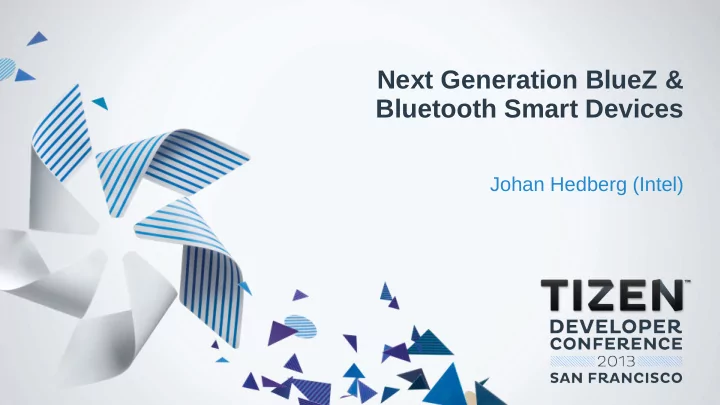

Next Generation BlueZ & Bluetooth Smart Devices Johan Hedberg (Intel)
Bluetooth – Short Introduction ● Short range wireless technology operating at 2.4 GHz ● Originally announced in 1998 as a replacement for RS-232 ● but has evolved way beyond that ● 1.1 in 2001 fixed many issues in the initial version ● 2.0 in 2004 with increased data rate from 1 to 3 Mbit/s ● 3.0 in 2009 with High Speed support together with WiFi ● 4.0 in 2010 with Low Energy (aka Bluetooth Smart) ● Bringing Bluetooth into many new kinds of devices 2
Bluetooth – Common Uses ● File transfer ● Contacts & Message access ● High quality audio streaming ● Media playback control ● Phone call control & audio ● Health care devices ● Human Input Devices ● Networking ● ...and many more 3
Bluetooth Low Energy ● A new 2.4 GHz technology reusing many features of Bluetooth ● Went through several names in its evolution ● Wibree, Ultra Low Power, Low Energy ● Now official branding ● Bluetooth Smart – For single-mode (LE-only) devices ● Bluetooth Smart Ready – For dual-mode (LE + traditional Bluetooth) ● Much lower power consumption – coin-cell battery is enough ● ...with the drawback of having less bandwidth than traditional Bluetooth ● Much faster connection creation ● Smaller penalty for being more often disconnected – saves more power 4
Bluetooth Smart Devices 5
Differences to traditional Bluetooth ● Connection model ● Scanning and Advertising ● All profiles based on the Attribute Protocol ● ATT = Attribute Protocol ● GATT = Generic Attribute Profile ● Device roles in matching pairs ● Central & Peripheral ● Observer & Broadcaster ● Security algorithms on the host side instead of the controller ● Privacy ● Random device addresses in addition to public ones 6
ATT & GATT ● A basis for all LE profiles ● Smallest logical unit – the attribute ● Type ● Value ● Permissions ● Hierarchy ● Profile ● Service ● Characteristic ● Read/write operations, indications & notifications 7
BlueZ
BlueZ - History ● Standard Linux Bluetooth stack since 2.4.6 (2001) ● BlueZ 2 in 2002 ● BlueZ 3 in 2006 ● First D-Bus release ● BlueZ 4 in 2008 ● Refined D-Bus ● Bluetooth 2.1 support ● BlueZ 5 end of 2012 ● Refined D-Bus ● Bluetooth 4.0 support 9
BlueZ – Maintainers & Contributors ● Maintainers ● Marcel Holtmann (Intel, Kernel & User Space) ● Johan Hedberg (Intel, Kernel & User Space) ● Luiz Von Dentz (Intel, User Space) ● Gustavo Padovan (Collabora, Kernel) ● Contributors ● 82 AUTHORS entries (people with > 10 commits or bigger patches) ● Intel, IndT, ProFUSION, TI, Qualcomm, Google, CSR, Atheros, etc. 10
BlueZ Contributor Companies 11
BlueZ – Main Features ● Core specification 4.0 (GAP, SDP, L2CAP, RFCOMM, GATT) ● Audio/media profile support (A2DP, AVRCP) ● Networking profile support (PAN) ● Input device profile support (HID) ● Health device support (HDP) ● File transfer (FTP, OPP) ● Message access (MAP) ● Phone Book Access (PBAP) ● ...and many more 12
BlueZ – General Architecture ● Hardware (HCI) drivers and lower level protocols in the kernel ● All standard HCI transports supported (UART, 3-Wire UART, USB, SDIO) ● BSD socket based abstraction to user space ● HCI, L2CAP, RFCOMM, SCO and Management sockets ● Profiles and higher level protocols in user space ● Central user space daemon (bluetoothd) extensible with plugins ● Separate obexd daemon for OBEX profiles ● D-Bus interfaces towards the UI and other subsystems 13
BlueZ Architecture - Visualized FTP MAP PBAP OPP Audio Networking Input Health etc User Space obexd bluetoothd HCI L2CAP RFCOMM SCO MGMT SMP Kernel Bluetooth Subsystem Core 14
Integration with other subsystems ● ConnMan ● Networking (PAN) support ● oFono ● Hands-Free Profile (HFP) support ● Dial-Up Networking (DUN) support ● PulseAudio ● Audio streaming support (both HFP and A2DP) ● neard ● NFC support (automatic pairing & connection creation) 15
BlueZ – Low Energy Support ● Available since Linux Kernel 3.5 and BlueZ 5.0 ● Kernel level features: ● Generic Access Profile (GAP) ● Security Manager Protocol (SMP) ● Interface to user space is mostly the same as for traditional Bluetooth ● User space features: ● Attribute Protocol & Generic Attribute Profile ● Profiles implemented through plugins ● Profile-specific D-Bus interfaces ● (WIP) Generic GATT D-Bus interface for external custom profiles 16
Current Low Energy Profiles in BlueZ ● Proximity (keep track of your things) ● Immediate alert (similar to proximity) ● Health thermometer ● Time (sync time from phone to watch) ● Battery (know when your LE device needs a new one) ● Human Interface Device (mice and keyboards) ● Heart rate (sport heart rate belts, medical) 17
Using & Developing LE profiles with BlueZ ● GATT library available for bluetoothd plugins ● All existing profiles use this ● Both server and client roles ● Existing profiles have D-Bus interfaces to allow implementing UIs (e.g. a heart rate monitor) ● Custom/proprietary profiles need a custom plugin right now ● Generic GATT D-Bus API on its way 18
Ongoing work and near-future features for BlueZ ● GATT D-Bus API ● AVRCP enhancements (AVRCP 1.5) ● HFP 1.6 with Wide-Band Speech (mSBC) ● MAP enhancements ● LE Connection model re-factoring ● Following up on upcoming (non-public) specifications 19
Low Energy and Tizen ● Enables many new use cases across the different verticals ● Tizen already has a good Bluetooth API ● Proper LE API needs defining and making official ● Generic GATT D-Bus API for BlueZ ● Needed for custom GATT profiles external to BlueZ ● Work on the way 20
Recommend
More recommend